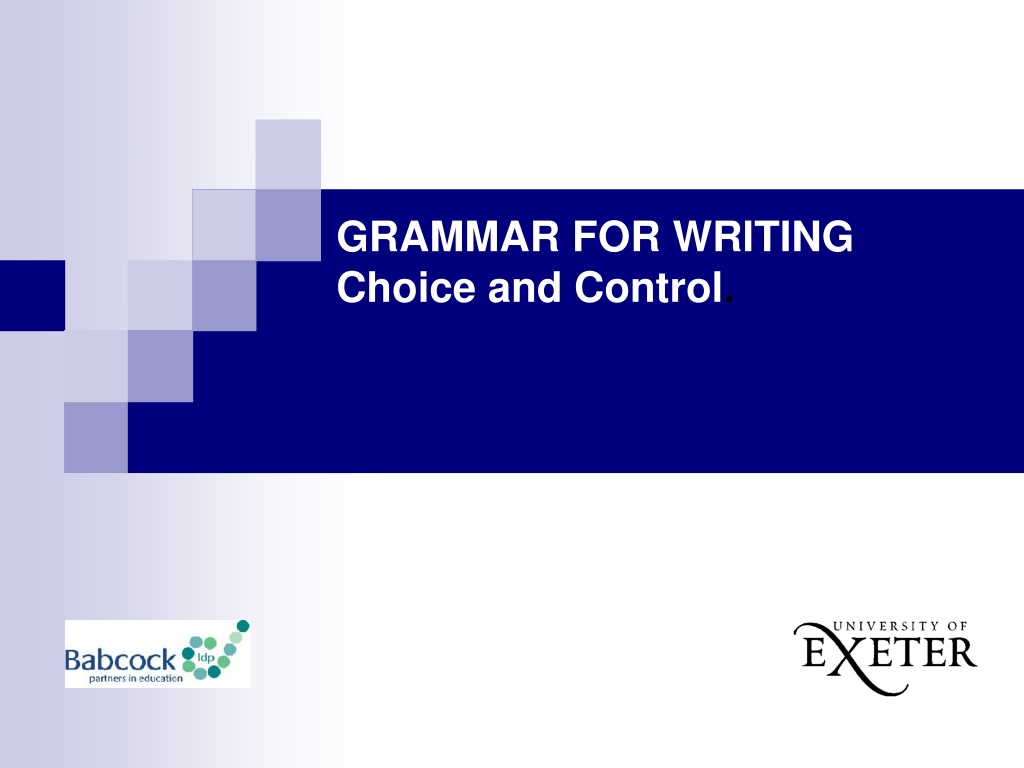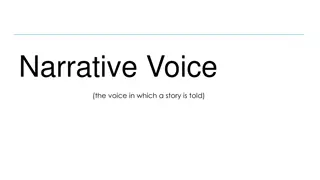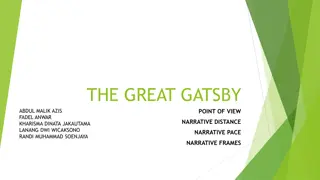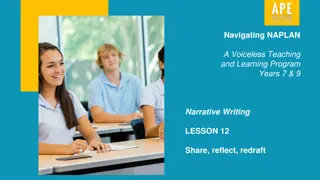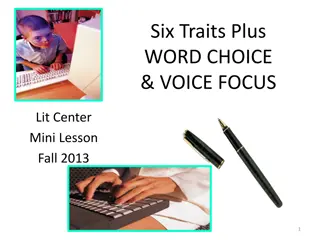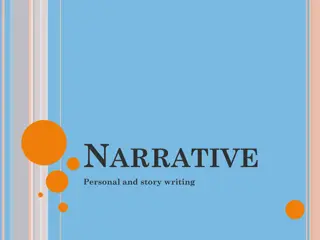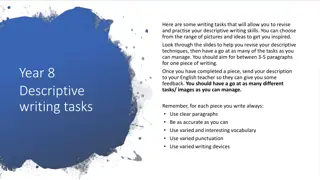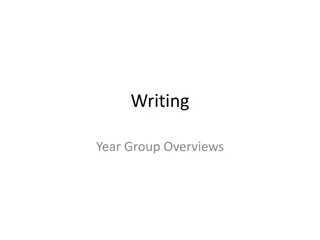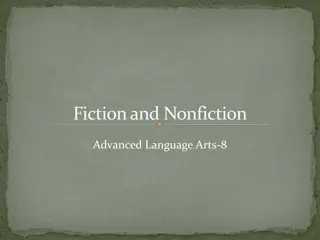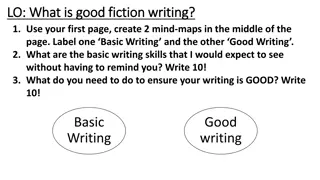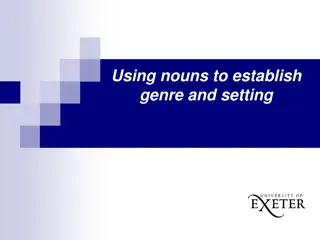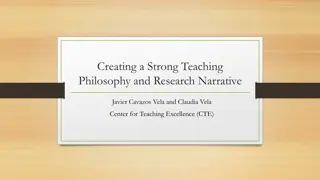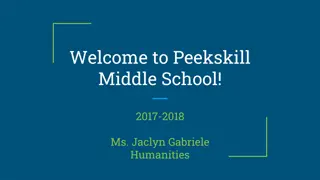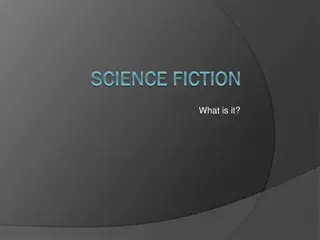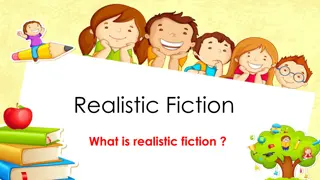Teaching Writing Creatively for Narrative Fiction
Explore the principles of teaching writing creatively for narrative fiction, emphasizing the importance of engaging young writers' imaginations, emotions, and beliefs. Learn how to create an enriching environment that encourages exploration and experimentation in the writing process. Discover how everyday objects can be transformed into enchanted objects with special powers, adding depth and magical elements to storytelling.
Download Presentation

Please find below an Image/Link to download the presentation.
The content on the website is provided AS IS for your information and personal use only. It may not be sold, licensed, or shared on other websites without obtaining consent from the author. Download presentation by click this link. If you encounter any issues during the download, it is possible that the publisher has removed the file from their server.
E N D
Presentation Transcript
GRAMMAR FOR WRITING Choice and Control.
Aims of Session: CPD Day 2 To re-iterate the teaching principles underpinning the writing intervention; To secure grammatical subject knowledge of the noun phrase and subject-verb inversions; To understand the teaching approaches in the narrative fiction SoW. 3
GfW: Four Key Teaching Principles Make a link between the grammar being introduced and how it works in the writing being taught; Explain the grammar through examples, not lengthy explanations; Build in high-quality discussion about grammar and its effects. Use examples from authentic texts tolinks writers to the broader community of writers. 4
Teaching Writing Creatively To write well we all need to have something to say and a desire to say it; Before young writers can meaningfully attend to how they have written something, they need to have engaged with what they want to say the ideas; Engaging young writers imaginations, emotions and personal beliefs is a really important part of teaching writing; Allowing young writers freedom to explore ideas, test things out, and to write to find out what they want to say is critical We often move far too quickly to pinning things down, and making writing a very linear process we need to create space for exploration, experimentation and re-drafting. This is built into both of our Schemes of Work. 5
Enchanted Objects in King Arthur Any everyday object can become an enchanted object: stones; rings; goblets; swords; cloaks; boxes; potions Enchanted Objects each have special power, enchanted by a wizard or witch: The evil witch, Nimueh, casts a spell on a dragon egg and she throws into the water supply for the castle. The next day a plague erupts: people s skin turns white with dark blue veins, and many die; Enchanted objects can be good or evil; and their enchantment can only be overcome by more powerful magic. They are sometimes named to show who or where they come from: The Stone of Astolat; The Goblet of Morgana. 6
Teaching Writing Creatively Narrative Fiction Scheme of Work Magpie books: so they can play with drafting little sections of the story a description of a character; plot outlines; plot events. Encourage experimentation and playfulness in these books, including free-writing or multiple versions of drafts. Magic Silence: creating imaginative space for writing in a calm and uninterrupted atmosphere; some teachers use a signal for this (windchime); you could also use very gentle, low volume background music Creative starting points: enchanted objects; picture/video stimuli; visualisation; teacher storytelling The Writing Process: gives space for idea generating, planning, outlining, drafting and revising throughout the scheme, and Week 4 pays particular attention to supporting drafting and revising. 7
Noun Phrase and Subject-Verb inversions GRAMMAR SUBJECT KNOWLEDGE 8
Slots in a clause Subject Verb Object Adverbial Complement (adjective) / Complement (noun) Gregor ate bread greedily. Beauty s father was eating the freshly baked bread in the sumptuous palace. Gregor was hungry. Gregor was her father.
Slots in a clause game S S S A A A A V V V S A S V O A V S V S O V A A A A
Subject Verb Inversion Into a forest of fifty thousand trees rode a lone traveller. Beauty and Beast- Geraldine McCaughrean And there, at last, was the robin. Arthur, High King of Britain Michael Morpurgo In the west of the city was a fabulous garden. The Paradise Garden Colin Thompson In went the sun and down came the rain.
Other uses of SV inversion Speech: There s a light up ahead, said Gregor. With a complement: Van Gogh was famous for the vibrancy of his paintings. Most famous were his sunflower paintings. Equally inexplicable was his behaviour towards his son.
Other ways to create the same effects Delaying/distancing Through the dark night a darker shape slid. Beowulf Kevin Crossley Holland Every corridor was lined with great gilded mirrors, each one cracked like broken ice. Every vase was filled with fresh flowers, every statue blindfolded with a scarf of silk. Beauty and the Beast Geraldine McCaughrean Cohesion Triops erupt from this new source of life. These minnow like crustaceans grow domed shells that look like tiny horseshoe crabs. Survival at 40 Above Debbie S. Miller
Big Ideas: Subject Verb Inversion Writers can choose to reverse the typical subject verb pattern within a clause to create particular effects including: In narrative: distance, mystery, delay In non-fiction (with a complement): cohesion
Slots in a clause Subject Verb Object Adverbial Complement (adjective) / Complement (noun) Gregor ate bread greedily. Beauty s father was eating the freshly baked bread in the sumptuous palace. Gregor was hungry. Gregor was her father.
So how do we construct a noun phrase? Add some adjectives Change the determiner
Developing the noun phrase by adding words before the main noun: pre-modification Determiners Adverbs Adjectives Noun Head Noun dragon wings claws tail head body a, an, the this, that, these, those, some, any, my, our, his, their, several, few, last, next, first, seventh, six, twelve slightly very extremely rather quite fierce hooked deadly black spiked steely-ribbed ribbed scaly rough grey veined stone mountain fire 19
My dragons are tiny, with whisper whisper- -thin wings of rainbow hues. thin wings of rainbow hues. Jackie Morris
So how do we construct a noun phrase? Add some adjectives Change the determiner Add a prepositional phrase (with of )
Prepositions under beside
He swam to the bottom of the deepest ocean. He climbed to the tops of the tallest trees. whisper-thin wings of rainbow hues. 24
So how do we construct a noun phrase? Add some adjectives Change the determiner Add a prepositional phrase (with of ) Add a relative clause (who, that, which )
Using a relative clause Relative pronoun who Example, with noun phrase emboldened The small boy, who was hiding from the dragon, sneezed. which His broken wing, which dragged on the floor, was of no more use. He had a broken wing which dragged on the floor. The dark cave, that appeared before them, was the refuge they sought. that Relative pronouns: who, whom, whose, which, that
Developing the noun phrase by adding words after the main noun: post- modification Noun Adjective Relative clause Non Finite Clause Prepositional phrase dragon wings body spiky delicate rough scaly turquoise jade-green fierce with steel- grey spikes which rules the skyline towering above the world of immense strength who towers above the horizon, silhouetted against the darkening skies that terrorises the valleys
So how do we construct a noun phrase? Complete the sentence and change the mood.
The Ice Bear Jackie Morris a piece of amber, smoothed by oceans, coloured, clear and beautiful, like a fragment of fire, washed ashore from a far off place. 29
Dragonology Dugald A. Steer Essential Equipment: A reasonably powerful magnifying glass Special heat-proof clothing A relief map of the area, that shows both flora-types and geological formations Abramelin s Taming Spell Take three troy ounces of dragondust from a silver dish that has been thrice washed in water that has reflected a new moon. 30
An enchanted object Read your writing with a partner and explore your use of noun phrases. Compare these with the writing about the dragon picture. Is there anything you would change and why? 31
Big Ideas: Noun Phrases Nouns can be expanded in many ways Additional information can be added before the noun and after the noun (pre and post- modification) Nouns can be expanded with single words, phrases and clauses The choice of vocabulary used within a noun phrase determines the mood/picture in the reader s mind/information conveyed
Narrative fiction ARTHUR, MERLIN AND THE KNIGHTS OF THE ROUND TABLE 33
SoW Overview Week 1: Story-building and understanding narrative structure Week 2: Word choices, especially noun phrases, and how they help create character Week 3: Sentence shaping and how it supports plot development and revising text Week 4: Designing text focusing on drafting and revising 34
Narrative Structure Week 1: Key Focuses Use of story mountain image and structure The image deliberately has two peaks to avoid suggesting too rigid a story structure Activities which secure understanding of story structure The concepts of problem and climax are the hardest: try to ensure these are securely understood The idea of bare bones being just the plot; and how as writers we have to flesh it to make it an engaging story 35
Developing Character Week 2: Key Focuses From visual images to verbal painting in words Helping readers see our characters Using noun phrases to paint pictures Using well-chosen nouns rather than too many adjectives Developing descriptive post-modification in noun phrases Making readers infer about our characters through show not tell 36
Creating Character CREATING VISUAL IMAGES IN WORDS 37
From visual to verbal The video clip in words: Then, out of the darkness, came a lady, dark-haired and beautiful, wearing a gown of wine-red. She stood over the burial casket of a knight and began to speak in a strange language, the words flowing from her lips like a dark song. She raised her arm over the casket, her long fingers extended, and her eyes, wide and intense. The flow of words grew louder, the lady s voice grew stronger and more insistent, until almost shrieking, she spoke the name, Uther Pendragon! 38
Noun Phrases to Build Description Sometimes noun phrases are built by putting adjectives before the noun: a strange language a dark song her long fingers Look at your description of a character from the Arthur and Merlin stories: have you created any noun phrases like this? What did you want to make your reader see or think about your character? 39
Noun Phrases to Build Description You can also build noun phrases by adding more description after the noun You could add adjectives: her fingers, long, white and dancing, her eyes, wide and intense, a lady, dark-haired and beautiful, You could add a prepositional phrase: the colour of honey the hood of his dark cloak You could add a non-finite clause beginning with an ing or ed verb: gold washed in milk a lady, dark-haired and beautiful, wearing a gown of wine-red the words flowing from her lips
Describing Characters Building detail by adding information after the noun (post-modification): Character Determiner NOUN Adjectives Non-finite clause Merlin his parchment-silver etched with age face Guinevere her long, white and dancing dark-haired and beautiful fingers Morgana a wearing a gown of wine-red lady Morgana the flowing from her lips words 41
https://encrypted-tbn1.gstatic.com/images?q=tbn:ANd9GcR4_Eq4PuVDjMMrgP5OOY0CrDrV8E9rG2N0U8S7p9PvMeFIwgBEhttps://encrypted-tbn1.gstatic.com/images?q=tbn:ANd9GcR4_Eq4PuVDjMMrgP5OOY0CrDrV8E9rG2N0U8S7p9PvMeFIwgBE Examples of Noun Phrases her fingers, long, white and dancing, her eyes, wide and intense, a lady, dark-haired and beautiful, the hood of his dark cloak, his face, parchment-silver and etched with age CREATE YOUR OWN NOUN PHRASE TO DESCRIBE THIS CHARACTER AND PAINT A PICTURE OF HIM IN WORDS 42
From visual to verbal One aspect of writing is conveying in words the images we have in our heads of characters and scenes We have to paint in words Well-chosen noun phrases help us to paint a visual picture of our characters for our readers In general, better writers use more post-modification; weaker writers use very little modification but if they do it is before the noun Better writers use fewer adjectives before the noun; and choose stronger nouns 43
Creating Character MAKING THE READER INFER: SHOW NOT TELL 44
Show, not Tell: make your reader infer When we describe characters for our readers, sometimes we tell them directly about the character: here s Roald Dahl s description of Mr and Mrs Wormwood s house:- Matilda s parents owned quite a nice house with three bedrooms upstairs, while on the ground floor there was dining-room and a living- room and a kitchen This gives us precise information about their house. But good writers also make the readers think about, or infer, what characters are like from a description: Mr Wormwood was a small ratty-looking man whose front teeth stuck out underneath a thin ratty moustache. This description is not just information about what Matilda s dad looks like: by showing us what he looks like, Dahl also makes us think, or infer, about what kind of man he is. What kind of a man is ratty-looking ? What do we think about rats as creatures? How different it would have been if Dahl had described him as a cuddly bear-like man ? 45
Show, not Tell: make your reader infer Show not tell: Dahl doesn t tell us that Mr Wormwood is a nasty little man, he tells us he is ratty-looking and so shows us he is a nasty little man. We have to work this out for ourselves (or infer this). When we write, sometimes we do tell our readers about characters, but good writers also make the reader infer what the character is like. 46
Show, not Tell What does the physical description of the man and his horse suggest about his character? What might a reader think about a man who is completely green? What does the description of how the man arrives suggest about his character? At that moment, from outside in the courtyard, came the clatter of horses hooves on the cobbles. The doors of the hall flew open, and before I had time to call for them to be closed, a giant of a man rode in on a towering warhorse that pawed the ground, sides lathered up, tossing its fine head, snorting its fury. The man swept the hall with terrible eyes, wolfish eyes that froze the courage in a man s veins, eyes you could not hold with your own. But it was not the man s eyes that amazed us most, it was not his size either - and I tell you I d never in my life set eyes on a bigger man no. It was the colour of him. Green, the man was green from head to foot. Arthur, High King of Britain by Michael Morpurgo 47
Show, not Tell: through noun phrases At that moment, from outside in the courtyard, came the clatter of horses hooves on the cobbles. The doors of the hall flew open, and before I had time to call for them to be closed, a giant of a man rode in on a towering warhorse that pawed the ground, sides lathered up, tossing its fine head, snorting its fury. The man swept the hall with terrible eyes, wolfish eyes that froze the courage in a man s veins, eyes you could not hold with your own. But it was not the man s eyes that amazed us most, it was not his size either - and I tell you I d never in my life set eyes on a bigger man no. It was the colour of him. Green, the man was green from head to foot. 48
Show, not Tell: through noun phrases At that moment, from outside in the courtyard, came the clatter of horses hooves on the cobbles. The doors of the hall flew open, and before I had time to call for them to be closed, a giant of a man rode in on a towering warhorse that pawed the ground, sides lathered up, tossing its fine head, snorting its fury. The man swept the hall with terrible eyes, wolfish eyes that froze the courage in a man s veins, eyes you could not hold with your own. But it was not the man s eyes that amazed us most, it was not his size either - and I tell you I d never in my life set eyes on a bigger man no. It was the colour of him. Green, the man was green from head to foot. 49
Show, not Tell: through noun phrases the clatter of horses hooves on the cobbles . a towering warhorse that pawed the ground, sides lathered up, tossing its fine head, snorting its fury a giant of a man terrible eyes, wolfish eyes that froze the courage in a man s veins, eyes you could not hold with your own a bigger man the colour of him Michael Morpurgo shows us through his noun phrases that: He is a giant of a man so he is likely to be strong, possibly fierce; His horse is towering and it is a warhorse so he must be a fighting man; The man has terribleeyes, like a wolf s (wolfish ), and it makes the other knights frightened (froze the courage in a man s veins) so he might be evil or nasty The man is a strange colour (green) what kind of man is green? 50
